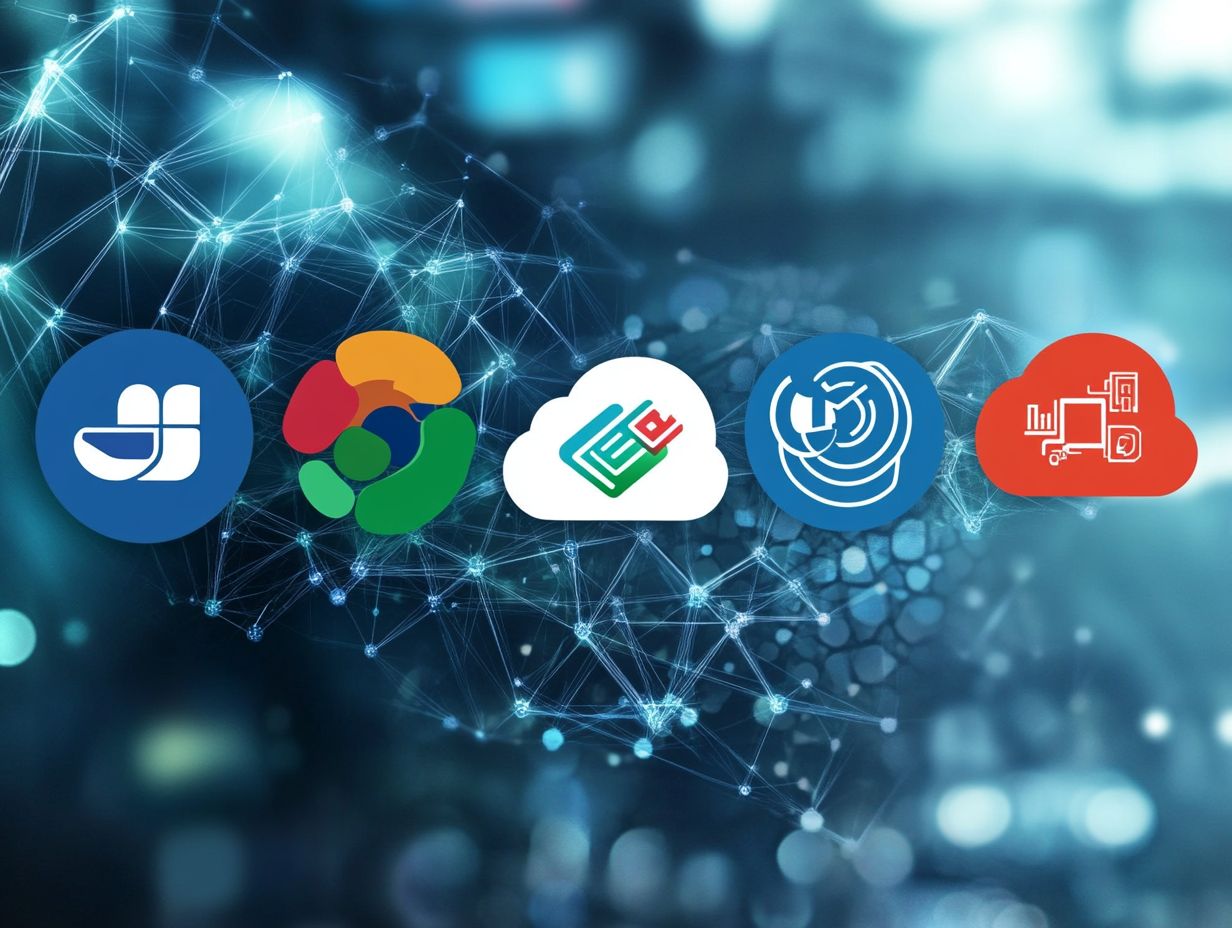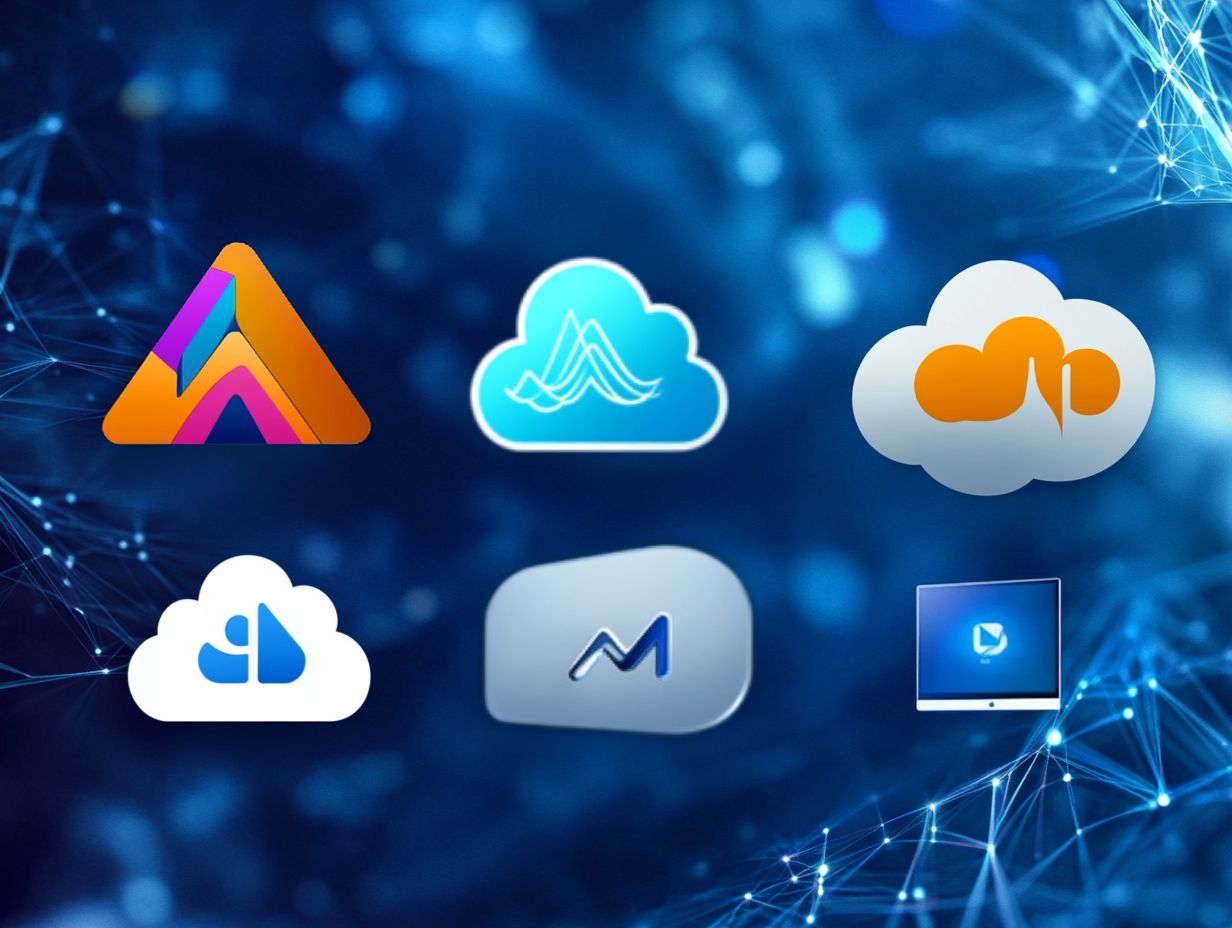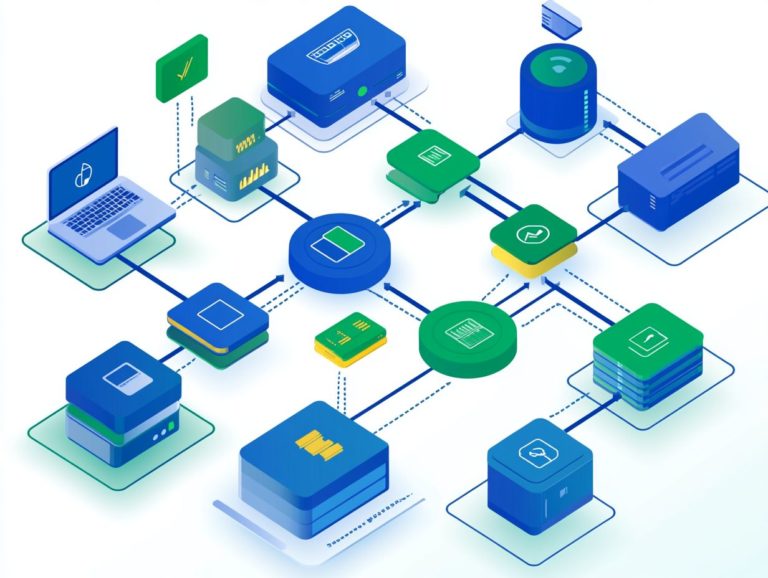5 Companies Leading the PaaS Revolution
PaaS is changing the game for businesses everywhere! It transforms how companies develop, test, and deploy applications.
This article explores five leading PaaS providers: Amazon Web Services, Microsoft Azure, Google Cloud Platform, IBM Cloud, and Salesforce Platform. We ll showcase their unique offerings and capabilities.
We ll also look at key features of PaaS, its benefits, challenges, and future trends. Whether you re considering a PaaS solution or want to improve your current setup, this guide will help you navigate your options confidently.
Contents
- Key Takeaways:
- 1. Amazon Web Services (AWS)
- 2. Microsoft Azure
- 3. Google Cloud Platform (GCP)
- 4. IBM Cloud
- 5. Salesforce Platform
- What Is PaaS and How Does It Work?
- What Are the Key Features of PaaS?
- How Is PaaS Different from Other Cloud Computing Models?
- What Are the Benefits of Using PaaS?
- What Are the Common Use Cases for PaaS?
- What Are the Challenges of Adopting PaaS?
- How Can a Business Choose the Right PaaS Provider for Their Needs?
- What Are the Future Trends in PaaS?
- How Can PaaS Revolutionize the Way Businesses Operate?
- What Are the Potential Risks of Using PaaS?
- How Can a Business Successfully Implement and Utilize PaaS?
- Frequently Asked Questions
- 1. What is PaaS and why is it considered a revolution in the tech industry?
- 2. Which companies are leading the PaaS revolution?
- 3. What makes Amazon Web Services a leader in the PaaS market?
- 4. How does Microsoft Azure stand out in the PaaS market?
- 5. Why is Google Cloud Platform a top player in the PaaS market?
- 6. What sets IBM Cloud apart in the PaaS market?
Key Takeaways:

The top five companies leading the PaaS revolution are AWS, Microsoft Azure, Google Cloud Platform, IBM Cloud, and Salesforce Platform.
PaaS offers features like scalability, flexibility, and cost-effectiveness. It can transform how businesses operate, but challenges and risks must be managed.
1. Amazon Web Services (AWS)
Amazon Web Services is a leader in cloud solutions. It helps you enhance performance and scalability, especially for real-time data processing in IoT systems.
A standout offering is AWS IoT Greengrass. It integrates with industrial environments, allowing you to build applications right at the edge.
This service supports local data processing and machine learning while keeping a secure connection to the cloud. Features like encryption and identity management protect your data.
You can efficiently manage resources across multiple devices. This optimizes operations in real-time and boosts system reliability.
2. Microsoft Azure
Microsoft Azure excels in hybrid cloud solutions. You can integrate on-premise edge capabilities with extensive cloud resources.
This integration is especially useful in industries like manufacturing, where quick decision-making is crucial. Azure IoT Edge enables data collection and analysis right at the source.
With Azure’s power, you can scale operations and support real-time analytics. This streamlines production and helps your business adapt to market changes.
3. Google Cloud Platform (GCP)
Google Cloud Platform offers a wide range of services for managing data across IoT systems. You can utilize Google s advanced analytics capabilities effectively.
With a focus on artificial intelligence and machine learning, GCP helps you process data quickly. This revolutionizes your operations.
GCP s solutions foster collaboration among development teams, making application deployment seamless. As you move toward decentralized architectures, GCP ensures data security and reliability.
4. IBM Cloud
IBM Cloud offers you a wide range of cloud services that seamlessly integrate strong security features and Platform as a Service (PaaS) offerings. This allows your business to develop and deploy applications with confidence, especially in sensitive industrial edge environments.
This approach makes your work easier and ensures that data transmitted from your manufacturing sites is shielded from cyber threats.
When you combine this with Watson’s AI capabilities, IBM Cloud elevates your real-time data analytics. It enables predictive maintenance and enhances your decision-making processes.
By harnessing AI at the edge, you will optimize your workflows and cut down on downtime!
The cloud s infrastructure supports rapid scalability, which is essential for manufacturing sectors needing to stay agile in the face of swiftly changing market demands.
This combination of advanced technologies and security measures creates a resilient framework, allowing you to innovate boldly without compromising safety.
5. Salesforce Platform
The Salesforce Platform stands out as a premier PaaS solution, enabling you to build and deploy applications seamlessly in the cloud. This enhances your customer relationship management with robust tools and effortless integration into your existing cloud frameworks.
By incorporating edge computing solutions, you can elevate your application development capabilities. This integration enables you to process data closer to its source, significantly reducing latency and improving response times.
As a result, customer engagement on your site reaches new heights. Users enjoy quicker access to services and an overall enhanced experience.
Real-time insights derived from edge computing allow you to make informed decisions swiftly, ultimately leading to a more personalized and effective customer experience.
This combination of technologies helps you stay agile and competitive in today s dynamic digital landscape.
What Is PaaS and How Does It Work?

Platform as a Service (PaaS) is a type of cloud service that streamlines application development and software deployment. It offers a comprehensive environment complete with infrastructure, tools, and services allowing you to concentrate on crafting innovative applications without the headaches of managing the underlying hardware.
This model includes essential components, such as development frameworks that simplify coding processes and database management systems tailored for efficient data storage.
By utilizing the strength of PaaS, your organization can enjoy unparalleled scalability. This ensures that your applications can grow and evolve in response to shifting user demands.
With real-time access to data, PaaS solutions enable you to develop dynamic applications that react instantly to user interactions.
In the domain of edge computing, the importance of PaaS becomes even clearer. It supplies the vital infrastructure needed to support distributed applications, enhancing performance and reducing latency while fostering seamless connectivity across remote devices.
What Are the Key Features of PaaS?
PaaS provides you with key features that can transform your development experience. You ll enjoy simplified application development, automated software deployment, and remarkable scalability, enabling you to manage resources efficiently as application demands change.
Beyond these core benefits, this model typically includes robust built-in development tools that streamline the coding process. This allows your team to build applications quickly and effectively.
Enhanced collaboration capabilities enable multiple developers to work together in real-time, fostering effective communication essential for navigating today s fast-paced environment.
Moreover, its seamless integration with IoT systems opens the door to innovative data collection and processing. This equips your business to harness real-time analytics.
By leveraging these features, you can elevate your hybrid cloud strategies. Ensure a flexible and responsive infrastructure that adapts to the ever-evolving market demands.
How Is PaaS Different from Other Cloud Computing Models?
PaaS offers a complete environment for developing and deploying applications. This lets developers focus on coding instead of managing infrastructure.
In contrast, IaaS (Infrastructure as a Service) provides raw computing resources. It enables you to rent virtual machines and storage solutions. This model is perfect for IT administrators and system architects who need complete control over their hosting environment.
For instance, Amazon Web Services (AWS) offers EC2 instances for intricate configurations. However, they come with the responsibility of managing everything, including security and updates.
On the other hand, SaaS (Software as a Service) delivers fully functional applications, such as Google Workspace or Salesforce, directly to end-users. This is ideal for those who appreciate an out-of-the-box solution without backend hassles. While SaaS may limit customization and flexibility, IaaS can be cumbersome for rapid deployment.
PaaS finds an elegant middle ground by offering tools and frameworks tailored for developers. This streamlines the coding process and alleviates some operational burdens.
What Are the Benefits of Using PaaS?
PaaS provides rapid application development and lower operational costs. It also enhances scalability for your business, empowering you to innovate and respond swiftly to market demands. To explore more, check out the 5 popular programming languages for PaaS to ensure you don’t get left behind!
This platform allows your teams to collaborate effortlessly, breaking down silos and fostering innovation across departments.
For example, consider a leading fintech company that harnessed PaaS to launch a secure mobile payment solution in record time, reflecting the top PaaS trends in 2024. They drastically cut their time-to-market.
With access to advanced development tools and pre-built features, your developers can focus on solving creative problems instead of tedious setup tasks. This enables them to deliver high-quality applications at an impressive pace.
By adopting a PaaS model, your organization can tap into a broader ecosystem of services. This cultivates partnerships that drive growth and enhance efficiency.
What Are the Common Use Cases for PaaS?
PaaS has common use cases across various industries, including application development, web hosting, and IoT system management. You can leverage cloud computing for innovative solutions tailored to your specific needs.
Take the financial sector, for example. Platforms like Heroku allow you to swiftly build, test, and deploy applications that securely manage sensitive transactions.
In educational organizations, you can utilize Google Cloud Platform to create collaborative learning tools and manage extensive databases with ease.
In retail, PaaS solutions help you establish integrated e-commerce platforms that seamlessly connect with your existing inventory management systems. This enhances your operational efficiency.
This versatility shows how different sectors can reap the benefits of rapid deployment and integration capabilities, fostering an agile environment that adapts to evolving consumer demands.
What Are the Challenges of Adopting PaaS?
Adopting PaaS comes with challenges, including vendor lock-in, integration complexities, and security concerns. You must navigate these to fully harness the benefits of cloud computing for application development.
As you begin this journey, you may face compatibility issues between new PaaS solutions and your existing IT infrastructure. This can lead to costly delays and operational disruptions.
Data security is another major concern. Transferring sensitive information to the cloud increases the risk of breaches.
To tackle these challenges, conduct thorough assessments of your current systems to ensure seamless integration. Implement robust security measures such as encryption and regular audits to protect your data.
Collaborating closely with service providers can help tailor solutions that perfectly match your unique requirements.
How Can a Business Choose the Right PaaS Provider for Their Needs?

Selecting the right PaaS provider requires careful attention to key factors. Consider the 5 essential features of a PaaS solution, the ability to grow with your business, security features, and your specific business needs.
The platform must align with your organization s goals. You should assess support for edge computing, which means processing data closer to its source for faster results.
Integration with IoT systems is also important. This allows seamless communication and data exchange.
Consider leading PaaS providers like:
- Google Cloud Platform, known for robust security and machine learning integrations.
- Microsoft Azure, recognized for its hybrid cloud capabilities.
- AWS, offering diverse tools tailored to various business needs.
This evaluation will set you up for growth and success!
What Are the Future Trends in PaaS?
Emerging trends in PaaS are transforming the cloud computing landscape. Focus areas include edge computing, enhanced security features, and integration with IoT systems for real-time data processing, as highlighted in the top 10 PaaS providers in 2024.
These advancements change how applications are built and foster a more agile development cycle. By integrating AI and machine learning, developers can create smarter applications that adapt to user needs.
Containerization technologies further enhance this process by enabling seamless deployment and scalability. This shifting paradigm paves the way for streamlined collaboration across teams, driving innovation and enhancing user experiences.
How Can PaaS Revolutionize the Way Businesses Operate?
PaaS can transform your business operations by streamlining application development processes. For those looking to implement it effectively, there are 5 things to consider before choosing PaaS. It allows for rapid deployment of solutions and fosters a collaborative environment for developers.
Take Spotify, for example. They’ve harnessed PaaS to enhance their music streaming services. This enables quicker updates and a superior user experience while sidestepping traditional development bottlenecks. To learn more about such platforms, check out the 5 PaaS tools every developer should know.
Similarly, Salesforce has redefined customer relationship management with its PaaS offerings. Businesses can customize solutions tailored to unique needs.
Integrating edge platforms can elevate this transformation by processing data close to its source. This improves response times and reduces latency, which is vital in industries like retail and manufacturing.
What Are the Potential Risks of Using PaaS?
Using PaaS can present risks such as data breaches, compliance issues, and over-reliance on the provider’s security features. It s crucial for you to assess these factors to safeguard your assets and maintain customer trust.
The reliability of your vendor is paramount. Any downtime or security lapse can significantly impact your operations. Imagine if your provider experiences a service outage it could halt your development and lead to financial losses.
To mitigate these risks, conduct thorough vendor assessments and establish robust service level agreements (SLAs). Regular security audits, implementing multi-factor authentication, and continuous monitoring of your cloud environments are essential for ensuring data integrity and compliance.
This approach allows you to leverage the advantages of PaaS while diligently protecting your interests.
How Can a Business Successfully Implement and Utilize PaaS?
Successfully implementing and utilizing PaaS requires a strategic approach involving careful planning, employee training, and continuous evaluation. This ensures that the platform aligns with your organization s objectives while fostering a culture of innovation.
To embark on this journey, start by establishing clear and measurable goals that define your PaaS objectives. Selecting the right provider is essential; you need one that meets your current technology needs and can grow alongside your organization.
Plan the integration with your existing systems meticulously to avoid disruptions to ongoing operations. Invest in ongoing support and training to enable your employees to harness PaaS effectively, driving productivity and innovation.
Conduct regular assessments to ensure your deployment remains effective and continues to meet your organization s evolving needs.
Frequently Asked Questions
1. What is PaaS and why is it considered a revolution in the tech industry?

PaaS stands for Platform as a Service, a cloud computing model where a provider delivers a platform for developing, managing, and deploying applications. This is a game-changer for businesses because it eliminates the need for costly hardware and software infrastructure, allowing them to focus on application and service development.
2. Which companies are leading the PaaS revolution?
The top five companies leading the PaaS revolution are Amazon Web Services, Microsoft Azure, Google Cloud Platform, IBM Cloud, and the Salesforce Platform.
3. What makes Amazon Web Services a leader in the PaaS market?
Amazon Web Services (AWS) offers a wide range of PaaS products, such as AWS Elastic Beanstalk, AWS Lambda, and AWS Elastic Container Service. These tools empower developers to easily develop, deploy, and manage applications in the cloud.
4. How does Microsoft Azure stand out in the PaaS market?
Microsoft Azure provides a comprehensive PaaS solution with its Azure App Service, allowing developers to build web and mobile apps for any platform or device. Azure also features integrated tools for agile development, continuous integration, and DevOps.
5. Why is Google Cloud Platform a top player in the PaaS market?
Google Cloud Platform (GCP) offers a highly scalable and reliable PaaS environment with services like Google App Engine, Google Cloud Functions, and Google Kubernetes Engine. GCP s pay-per-use pricing model makes it a cost-effective choice for businesses.
6. What sets IBM Cloud apart in the PaaS market?
IBM Cloud provides a variety of PaaS options, including IBM Cloud Foundry, IBM Cloud Functions, and IBM Cloud Kubernetes Service. IBM Cloud also integrates well with other IBM services, such as Watson AI and blockchain, making it a popular choice for businesses seeking a comprehensive PaaS solution.
Ready to revolutionize your business with PaaS? Explore our services today!






